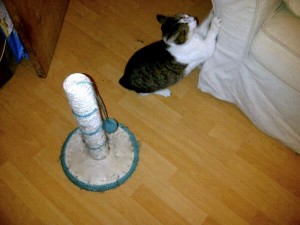Early experiences with cats
You’d assume, given my obvious obsession with felines that all my early memories are of wonderfully gentle animals that inspired me to be close to them. That’s not actually the case. I certainly had situations with cats in my younger years that were less than pleasant.
One of my first memories of interaction with a cat was when I followed the family cat behind the settee to give her a fuss. Clearly, she’d gone behind the settee for a reason, but as a child I failed to read her very clear signals. I got swiped in the face for that mistake, which as an adult, I totally understand. The cat in question had no other clear way to show me she didn’t want to interact other than a very physical retaliation when she felt she couldn’t get away from me. She did minimal damage, and I was quite rightly, reprimanded for giving the cat unwanted attention.
Fast forward a few years to sitting on a pavement with someone else’s cat for around quarter of an hour, then getting up to go home. The cat was clearly enjoying the attention, and struggling to communicate that fact, he followed me down the road. When I didn’t turn or respond, he literally plunged one of his claws into the back of my leg. “Hey, look at me! I’m still here and I liked the cuddle I was getting.” I appreciate this is rather an abrupt way to get his message across, but given that it’s difficult for two species to really understand what the other is trying to say, he was forgiven too.
The fact is, cats do tell people what they think and feel; in their own way. They try to communicate things to us all the time. If a cat is regularly scratching furniture, it’s possible that they have no designated surfaces for that, or if they have, they’re positioned in places that a cat would feel no need to use them. After all, when a cat scratches, there’s a dual purpose. Not only is it to shed claw caps, but it’s also to scent mark their spaces. Some cats are utterly horrified at the prospect of using one litter tray for both toileting habits. And simple things, like the wrong receptacle for water can mean a cat will literally drink less than they’re meant to, because the item being used to hold the water makes it taste odd to them.
If your cat starts to exhibit a behaviour you don’t understand, it’s easy to chalk it up to them being badly behaved. But what really needs to be considered is if their instincts and natural behaviours are being met with their surroundings. That really is key to a happy, healthy cat.
A willing assistant illustrating the importance of the right location and type of post….

